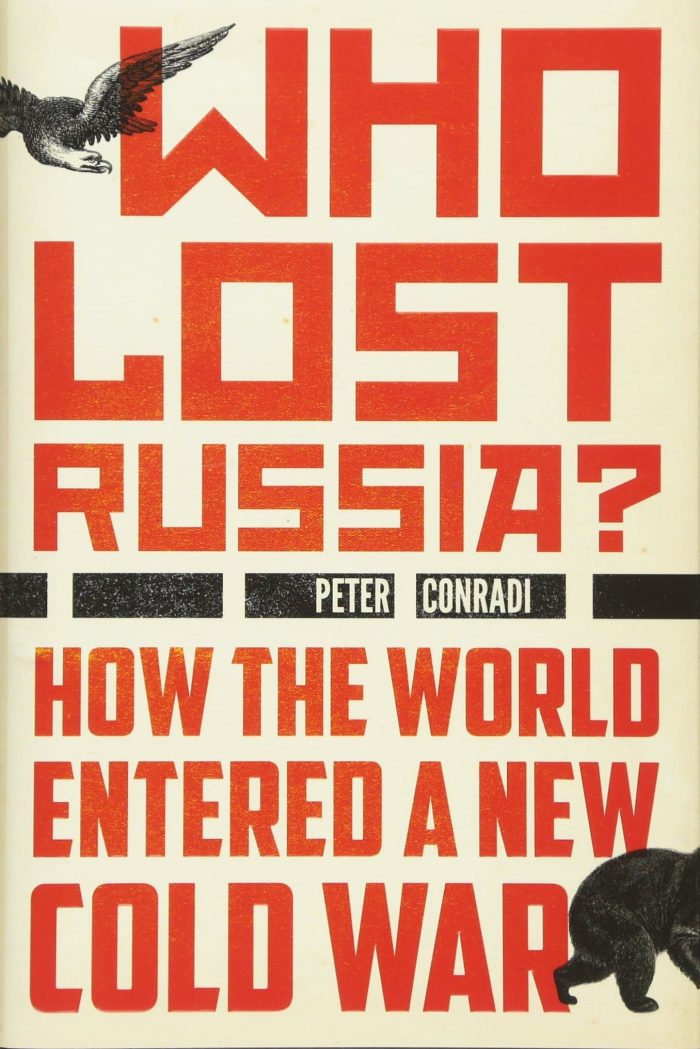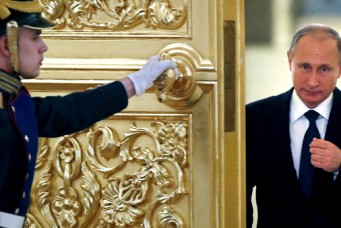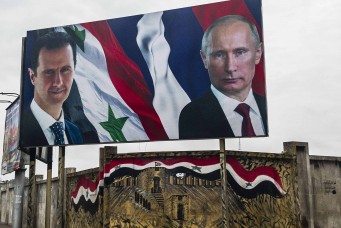From Russia, With Fear
How did Putin’s regime of fear and paranoia push Russia toward a new confrontation with the West?
Who Lost Russia? How the World Entered a New Cold War. By Peter Conradi. Oneworld, London, 2017. 370 pp.
In his new book, Peter Conradi, foreign editor of the Sunday Times and a former foreign correspondent in Moscow, demonstrates an excellent grasp of developments on both sides of the Atlantic—from the collapse of the Soviet Union to the election of Donald Trump. Yet “Who lost Russia?” is the wrong question to ask. Russia has never been the West’s to win or lose. It reminds one of the famous question asked after Mao came to power in Communist China in 1949; back then, it was “Who lost China?”
Much as the Chinese were nearly seven decades ago, Russians are their own agents in shaping the future of their country, even if their powerful—though not all-powerful—leader has his own interests in mind. The West can make matters better or worse, but is not so influential as to determine the future orientation of Russia—win it or lose it.
For years, Russian President Vladimir Putin has shown a strong preference for tense relations because of his need to portray the West—and in particular the North Atlantic Treaty Organization (NATO), the European Union (EU), and the United States—as threats to his grip on power. This enables him to justify, as Conradi notes, his authoritarian means of governing. Staying in power and protecting his ill-gotten gains are Putin’s primary objectives, even if that comes at the expense of good relations with the West.
Even before Putin returned formally to the presidency in 2012, the 2011 NATO-led military intervention in Libya authorized by the United Nations—Russia abstained—caused a major rift in relations, much like NATO’s action against Belgrade in 1999 affected President Boris Yeltsin’s relationship with Bill Clinton. Indeed, Libya may have been a major factor contributing to Putin’s decision to return to the presidency.
Putin came back spooked by anti-regime protests in late 2011, which he blamed on then-Secretary of State Hillary Clinton. The following year’s passage of the Sergei Magnitsky Rule of Law and Accountability Act prompted Putin to respond inhumanely by banning the adoption of Russian orphans by American citizens. The act angered Putin because it imposed a visa ban and asset freeze on Russian officials involved in gross human rights abuses, including the 2009 murder of Sergei Magnitsky, who worked for Hermitage Capital run by the British financier Bill Browder, a prominent campaigner for sanctions against the Kremlin. Ever since the Magnitsky Act became law, Russian officials have sought to reverse it through threats and propaganda campaigns. Putin’s grant of asylum to Edward Snowden the following year added fuel to the fire in U.S.-Russian relations. Russia’s invasion of Ukraine, which Conradi covers thoroughly, was the final straw, and relations have been in a steady downward spiral since. This past year, the Kremlin has attempted to force Browder’s arrest and extradition to Russia by issuing an Interpol “Red Notice.”
Putin’s resentment toward Hillary Clinton undoubtedly carried over into the 2016 American election, in which Russia grossly interfered by hacking into Democratic Party email accounts and then releasing their contents through Wikileaks. President Trump’s victory, initially celebrated in Moscow, Conradi writes, offered an opportunity to “find a way of putting America—and the West’s—relationship with Russia back on track.” Yet Russia’s unprecedented interference in last year’s U.S. presidential election, the resulting investigation into the Trump campaign, anti-Russian sentiment in Congress, as well as Russia’s ongoing aggression in eastern Ukraine and in Syria, prevented Trump from improving bilateral ties, much to the Kremlin’s frustration.
At the foundation of souring relations between the West and Russia is the collapse of the Soviet Union, and the West’s responsibility—or not—for the cowboy capitalism that followed. Conradi properly dismisses the notion that the West is to blame for Russia’s economic hardship and massive inequality in the 1990s, rejecting such claims as “absurd.” “The West may have provided the economic model,” Conradi explains, “but it was Russia’s own leaders—either out of ignorance or self-interest—who contrived to implement such ideas in an unfair way.” Shock therapy in the 1990s, combined with the “loans-for-shares” deal in which Kremlin-favored oligarchs got large shares in state-owned companies for a pittance, and massive corruption, put average Russians in a worse economic and financial position than under the Soviet period. That, of course, would change under Putin—not due to any real economic reforms he carried out, Conradi rightly argues, but because of the massive jump in the price of oil, boosting the Russian economy and Putin’s popularity with it.
Along with NATO’s bombing of Serbia in 1999, Conradi cites NATO enlargement into Eastern Europe as the source of early tensions in Russia’s relationship with the West. He acknowledges, however, that interest in joining the Atlantic alliance originated in countries that previously were part of the Soviet-led Warsaw Pact. Joining NATO, to leaders in the region, would underscore their countries’ “return” to Europe. Conradi equivocates on whether the various waves of enlargement—which peaked in March 2004 when seven former Soviet bloc countries joined the U.S.-led military alliance—were to blame for worsening relations. They certainly were a source of tension, but to have not enlarged NATO would have granted Russia a de facto veto over other countries’ aspirations, and that would have been much worse. Indeed, toward the very end, he rhetorically asks why the countries that wanted to join the “Soviet Union’s former satellites,” should see their desire “subjected to a Kremlin veto?” He includes the three Baltic states as rightful members of the alliance.
Like Henry Kissinger, whom he cites extensively in his book, Conradi draws the line when it comes to Ukraine and Georgia (or other countries that, rather than being satellite states under the Warsaw Pact, were former republics within the USSR itself). President George W. Bush’s attempt to extend the Atlantic alliance to those two countries, he argues, was “a step too far and an unnecessary provocation.” Conradi also questions how NATO would be able to defend these countries under Article Five guarantees. Conradi further criticizes the EU for its attempt to “force” then-Ukrainian President Viktor Yanukovych to choose between Russia and the EU in 2013. This, he states, was “the final straw” for Putin.
Conradi would do well to point out that European Union policy was not to blame; the fault lay with Putin and his zero-sum view of the region in which he tried to prevent his neighbors from deepening integration with the West, fearing such moves would threaten the system he oversaw in Russia. Moreover, keeping the door of Euro-Atlantic organizations open to aspiring countries such as Ukraine and Georgia is essential to ever fulfilling the vision of a Europe, whole, free and at peace, which was at the heart of both Bush administrations’ approach.
Conradi seems ready to draw a line—even a curtain, if you will—with Ukraine, Georgia, and other countries on the Russian side; yet these countries deserve to choose their own orientation and future without a threatening Russia breathing down their necks. With a population of roughly 44 million, Ukraine, for example, is too important and large geographically to consign to a Russian sphere of influence. Even the smaller countries in the region deserve to join Euro-Atlantic alliances, if they so choose and meet the criteria. Leaving them in a gray zone perpetuates instability and uncertainty on the European continent.
Putin tapped into the sense of resentment, and even a “thirst for revenge,” in Conradi’s words, among many Russians who wanted pride and order restored in their country. Boosted by the rise in the price of oil and his brutal handling of the Chechnya problem, Putin satisfied those Russians looking for a stronger Russia. His Munich speech in 2007, Conradi notes, marked the strongest articulation that Russia would no longer be pushed around by arrogant Western powers, especially the United States, that failed to show Moscow the proper respect. And yet as early as his post-Beslan speech in 2004—a year after the Rose Revolution in Georgia, and only two months before the following Orange Revolution in Ukraine—Putin was warning that “some would like to tear from us a juicy piece of pie,” suggesting that other powers wanted to keep Russia down.
Putin’s failure to understand that these were indigenous movements in countries along his borders fed his paranoia. The “color revolutions” had a major impact on Putin’s thinking, as Conradi describes, and scared him into thinking that the United States was behind them and that Russia was next on its list. It led Putin to take a hardened view toward any threats, foreign or domestic. This was especially true with Ukraine’s second revolution in less than a decade, when Viktor Yanukovych fled power, leading Putin to invade and annex Crimea, and then try his luck with eastern Ukraine. Putin refused to believe that Ukrainians, on their own, were capable of mobilizing against their country’s failing, corrupt leadership.
The interregnum of President Dimitri Medvedev didn’t provide a lasting breakthrough in relations. After all, it was during Medvedev’s presidency (even if Putin was ultimately calling the shots) that Russia invaded Georgia. That the Bush administration didn’t impose any real consequences on Russia for that violation of its neighbor’s sovereignty and territorial integrity, Conradi says, led Putin to believe he could get away with such actions. (As a former Bush administration official, I must admit that this is a fair criticism.) Such thinking was reinforced by the Barack Obama administration’s announced reset policy just months after Russian tanks had moved into Georgia. Coming so soon after Russia’s invasion of Georgia, the reset essentially swept that egregious act under the rug. The United States behaved as if it needed Russia more than the other way around. The reset was a failure on many levels and sent Moscow the wrong signals to the point where Putin thought he could get away with various actions, such as invading Ukraine and intervening in Syria, without paying much of a price.
By the end of the Bush administration, Conradi writes, “Putin saw Russia not as a junior partner, but as an equal.” “The Kremlin’s demands,” he adds, “could be summed up in a single word: ‘respect.’” That remained true during the Obama administration. The reset, according to Conradi, had its moments, most notably the 2011 Strategic Arms Reduction Treaty (New START Treaty), and cooperation on Iran and Afghanistan. But Putin’s formal return to the presidency, announced in September 2011 with the inauguration the following May, marked the end of Obama’s overtures.
In the penultimate chapter, rather puzzlingly, Conradi offers the views, based on interviews, of three Russians: Andrei Lugovoi, accused of the murder of Alexander Litvinenko in the U.K.; Dmitri Kiselyov, the epitome of Putin’s nauseating propaganda machine; and an unnamed Russian businessman. The selection of these three by the author seemed odd and out of place, as he offers no explanation to why they—all three are pro-regime—were chosen apart from others. Moreover, the chapter seemed to present the three men with a platform to express their views, which stands out from the narrative style in which Conradi wrote the other chapters of his book. In addition there are some minor things to fix: Nikita Khrushchev’s visit to the United States in 1959 was for twelve days, not twelve weeks; Putin is not technically an only child, as he had an older brother who died in 1942 during the siege of Leningrad, before the younger Vladimir was born.
At the very end of the book, Conradi rightly answers the question asked in his title by assigning responsibility for the current state of affairs to Putin, though he recognizes that the West has not been without its faults over the years. At the same time, he thinks the problems run deeper than Putin. The Yeltsin years, largely more pro-Western than those of his successor, Conradi predicts, will be seen more as the “aberration” than the norm represented by Putin. Still, Conradi faults Putin for Russia’s isolation while simultaneously and contradictorily seeking respect from the international community. The way Putin sought such respect, Conradi argues, through aggression against Russia’s neighbors, threats to others, and an ugly internal crackdown only instilled fear among his neighbors and beyond. The answer to Putin’s regime of fear and paranoia—as I argue in my own forthcoming book on U.S. policy toward Russia—is a return to the policy of containment. Until leadership changes at the Kremlin, bad relations with the West are Russia’s loss.
David J. Kramer is a senior fellow at the Václav Havel Program for Human Rights and Diplomacy at Florida International University’s Steven J. Green School of International and Public Affairs. Before that, he was senior director at the McCain Institute and served as the president of Freedom House, both in Washington, D.C. He served as Assistant Secretary of State for Democracy, Human Rights and Labor and Deputy Assistant Secretary of State for Europe and Eurasia during President George W. Bush’s administration. Most recently he authored Back to Containment: Dealing with Putin’s Regime.




